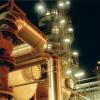Hello all,
I am trying to calculate the dissolution time of solid particles in some of our tanks. These tanks are not baffled, and they each have two propellers on the same shaft, mounted at a 45 degree angle. Based on literature, and the geometry of our equipment, I wanted to get the Power number from a Power number vs Reynolds number correlation table like the one attached to this message.
However, from my understanding, these graphs are for single impellers/propellers only. How do I account for the fact that my tanks have two propellers?
Thanks in advance.

 FB
FB











